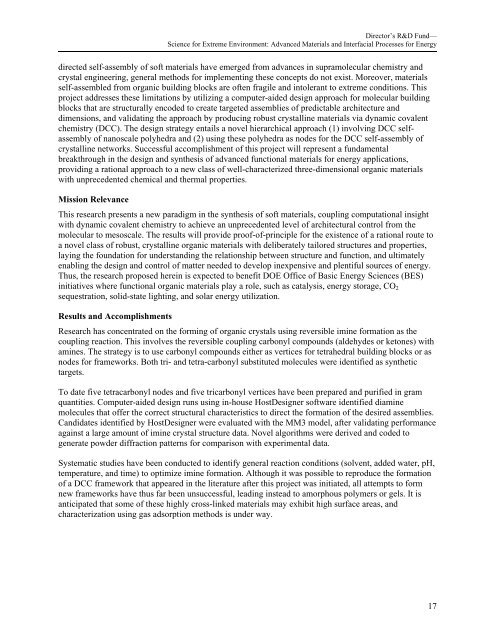FY2010 - Oak Ridge National Laboratory
FY2010 - Oak Ridge National Laboratory
FY2010 - Oak Ridge National Laboratory
You also want an ePaper? Increase the reach of your titles
YUMPU automatically turns print PDFs into web optimized ePapers that Google loves.
Director’s R&D Fund—<br />
Science for Extreme Environment: Advanced Materials and Interfacial Processes for Energy<br />
directed self-assembly of soft materials have emerged from advances in supramolecular chemistry and<br />
crystal engineering, general methods for implementing these concepts do not exist. Moreover, materials<br />
self-assembled from organic building blocks are often fragile and intolerant to extreme conditions. This<br />
project addresses these limitations by utilizing a computer-aided design approach for molecular building<br />
blocks that are structurally encoded to create targeted assemblies of predictable architecture and<br />
dimensions, and validating the approach by producing robust crystalline materials via dynamic covalent<br />
chemistry (DCC). The design strategy entails a novel hierarchical approach (1) involving DCC selfassembly<br />
of nanoscale polyhedra and (2) using these polyhedra as nodes for the DCC self-assembly of<br />
crystalline networks. Successful accomplishment of this project will represent a fundamental<br />
breakthrough in the design and synthesis of advanced functional materials for energy applications,<br />
providing a rational approach to a new class of well-characterized three-dimensional organic materials<br />
with unprecedented chemical and thermal properties.<br />
Mission Relevance<br />
This research presents a new paradigm in the synthesis of soft materials, coupling computational insight<br />
with dynamic covalent chemistry to achieve an unprecedented level of architectural control from the<br />
molecular to mesoscale. The results will provide proof-of-principle for the existence of a rational route to<br />
a novel class of robust, crystalline organic materials with deliberately tailored structures and properties,<br />
laying the foundation for understanding the relationship between structure and function, and ultimately<br />
enabling the design and control of matter needed to develop inexpensive and plentiful sources of energy.<br />
Thus, the research proposed herein is expected to benefit DOE Office of Basic Energy Sciences (BES)<br />
initiatives where functional organic materials play a role, such as catalysis, energy storage, CO 2<br />
sequestration, solid-state lighting, and solar energy utilization.<br />
Results and Accomplishments<br />
Research has concentrated on the forming of organic crystals using reversible imine formation as the<br />
coupling reaction. This involves the reversible coupling carbonyl compounds (aldehydes or ketones) with<br />
amines. The strategy is to use carbonyl compounds either as vertices for tetrahedral building blocks or as<br />
nodes for frameworks. Both tri- and tetra-carbonyl substituted molecules were identified as synthetic<br />
targets.<br />
To date five tetracarbonyl nodes and five tricarbonyl vertices have been prepared and purified in gram<br />
quantities. Computer-aided design runs using in-house HostDesigner software identified diamine<br />
molecules that offer the correct structural characteristics to direct the formation of the desired assemblies.<br />
Candidates identified by HostDesigner were evaluated with the MM3 model, after validating performance<br />
against a large amount of imine crystal structure data. Novel algorithms were derived and coded to<br />
generate powder diffraction patterns for comparison with experimental data.<br />
Systematic studies have been conducted to identify general reaction conditions (solvent, added water, pH,<br />
temperature, and time) to optimize imine formation. Although it was possible to reproduce the formation<br />
of a DCC framework that appeared in the literature after this project was initiated, all attempts to form<br />
new frameworks have thus far been unsuccessful, leading instead to amorphous polymers or gels. It is<br />
anticipated that some of these highly cross-linked materials may exhibit high surface areas, and<br />
characterization using gas adsorption methods is under way.<br />
17
















